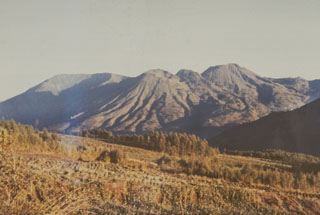Report on Dieng Volcanic Complex (Indonesia) — May 2018
Bulletin of the Global Volcanism Network, vol. 43, no. 5 (May 2018)
Managing Editor: Edward Venzke.
Research and preparation by Paul Berger.
Dieng Volcanic Complex (Indonesia) Phreatic explosion on 1 April 2018 at Sileri Crater
Please cite this report as:
Global Volcanism Program, 2018. Report on Dieng Volcanic Complex (Indonesia) (Venzke, E., ed.). Bulletin of the Global Volcanism Network, 43:5. Smithsonian Institution. https://doi.org/10.5479/si.GVP.BGVN201805-263200
Dieng Volcanic Complex
Indonesia
7.2°S, 109.879°E; summit elev. 2565 m
All times are local (unless otherwise noted)
Dieng has had a history of intermittent phreatic explosions. In 2017, explosions occurred on 30 April, 24 May, and 2 July (BGVN 42:10). Another phreatic explosion occurred on 1 April 2018. The volcano is monitored by the Pusat Vulkanologi dan Mitigasi Bencana Geologi (PVMBG, also known as Centre for Volcanology and Geological Hazard Mitigation or CVGHM).
PVMBG reported that a phreatic explosion at the Sileri Crater lake (Dieng Volcanic Complex) occurred at 1342 on 1 April 2018, ejecting mud and material 150 m high, and up to 200 m in multiple directions. The event was preceded by black emissions that rose 90 m, and then diffuse white emissions that rose 150 m. The report noted that few tourists were in the area due to rainy weather; visitors are not permitted within 200 m of the crater rim.
According to a news report (The Jakarta Post) that cited an official of the National Disaster Management Agency (BNPB), no toxic gases such as carbon dioxide, hydrogen sulfide, or sulfur dioxide were detected in the explosion.
Geological Summary. The Dieng plateau in the highlands of central Java is renowned both for the variety of its volcanic scenery and as a sacred area housing Java's oldest Hindu temples, dating back to the 9th century CE. The Dieng Volcanic Complex consists of multiple stratovolcanoes and more than 20 small Pleistocene-to-Holocene craters and cones over a 6 x 14 km area. Prahu stratovolcano was truncated by a large Pleistocene caldera, which was subsequently filled by a series of cones, lava domes, and craters, many containing lakes. Lava flows cover much of the plateau, but observed activity has been restricted to minor phreatic eruptions. Gas emissions are a hazard at several craters and have caused fatalities. There are abundant thermal features and high heat flow across the area.
Information Contacts: Pusat Vulkanologi dan Mitigasi Bencana Geologi (PVMBG, also known as Indonesian Center for Volcanology and Geological Hazard Mitigation, CVGHM), Jalan Diponegoro 57, Bandung 40122, Indonesia (URL: http://www.vsi.esdm.go.id/); Badan Nasional Penanggulangan Bencana (BNPB), National Disaster Management Agency, Graha BNPB - Jl. Scout Kav.38, East Jakarta 13120, Indonesia (URL: http://www.bnpb.go.id/); The Jakara Post (URL: http://www.thejakartapost.com).

